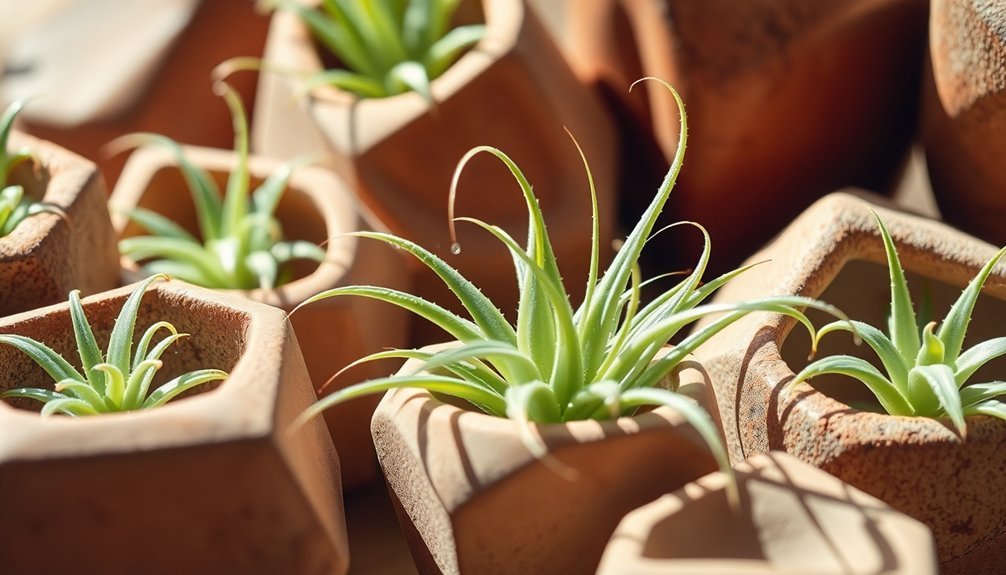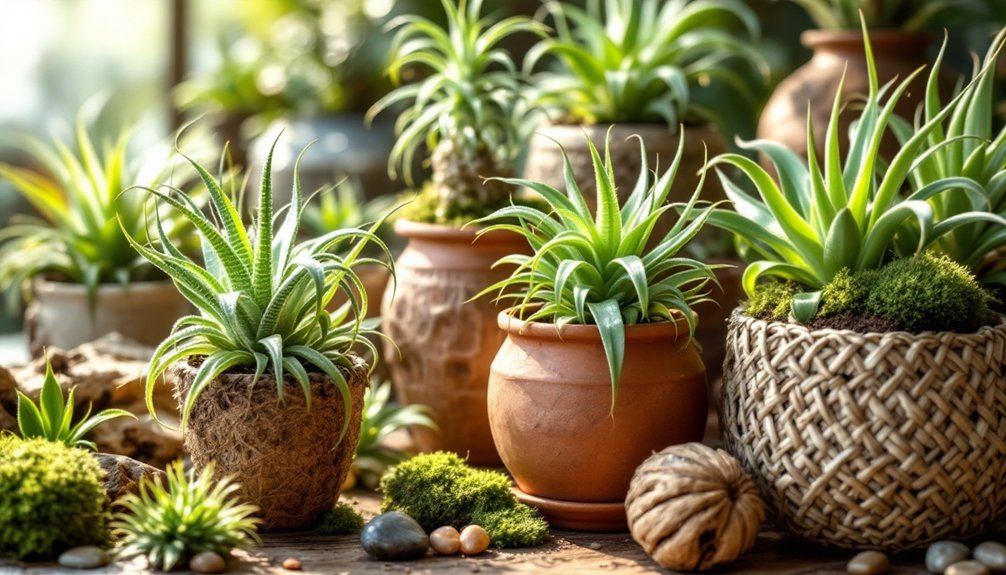For your Tillandsia to thrive, you'll want to choose from three top porous container options. Terracotta planters provide superior air circulation and natural moisture regulation, while wooden mounting displays transform your air plants into stunning living wall art. Porous ceramic holders offer the perfect blend of functionality and modern aesthetics. Each option promotes healthy growth through excellent airflow and moisture balance, and there's much more to discover about maximizing their potential.
Terracotta Planters: Nature's Breathing Vessels

When it comes to housing your Tillandsia, terracotta planters stand out as nature's perfect breathing vessels. These highly porous containers offer superior air circulation and moisture regulation, ensuring your air plants thrive in a well-balanced environment.
You'll appreciate how terracotta's breathable nature works to prevent root rot by absorbing excess moisture, a common challenge in Tillandsia care. The natural weight of these planters provides essential stability for your top-heavy air plants, keeping them securely in place.
As sunlight streams through your window, the planter's porous structure promotes healthy photosynthesis, while its rustic aesthetic appeal beautifully showcases your Tillandsia's unique shapes and colors. For ideal growth and visual impact, you won't find a better match than terracotta's time-tested combination of functionality and style.
Wooden Mounting Displays: The Living Wall Solution
A wooden mounting display transforms your Tillandsia collection into a stunning living wall masterpiece. You'll appreciate how untreated wood provides the perfect porous environment for your air plants, ensuring excellent air circulation and moisture dissipation. Secure your Tillandsia using non-invasive methods like wire or fishing line to protect their delicate root systems while creating an eye-catching display.
| Display Type | Benefits | Care Tips |
|---|---|---|
| Flat Panel | Enhanced air flow | Weekly misting |
| Vertical Garden | Space-saving design | Monthly soaking |
| Geometric Frame | Modern aesthetic | Natural drying |
| Branch Mount | Natural habitat look | Gentle securing |
| Grid Pattern | Easy arrangement | Regular rotation |
Remember to maintain your living wall's visual appeal through regular misting and proper care, allowing your air plants to thrive in their wooden home while creating a natural, organic aesthetic in your space.
Porous Ceramic Holders: Modern Design Meets Functionality

Beyond wooden displays, porous ceramic holders offer a perfect marriage of style and practicality for your Tillandsia collection.
You'll find these holders excel at providing essential air circulation while regulating moisture levels to prevent root rot in your air plants.
What makes these containers stand out is their blend of functionality and aesthetic appeal. The natural ceramic texture creates stunning decorative displays that complement your Tillandsia plants' unique foliage.
You'll discover a wide range of modern designs that seamlessly integrate into various home decor styles, whether your preference is minimalist, contemporary, or eclectic.
As a durable solution for displaying your air plants, porous ceramic holders prove to be a smart investment.
They're built to last, ensuring your Tillandsia collection maintains both ideal growing conditions and visual appeal for years to come.
Frequently Asked Questions
What Type of Container Is Best for an Air Plant?
You'll want a porous clay container that's 6-8 inches wide with drainage holes. It's perfect for airflow and moisture control, won't block your plant's leaves, and helps prevent root rot.
What Do You Put Tillandsia In?
You'll want to place your tillandsia in clay, ceramic, or glass containers with drainage holes. You can add aquarium gravel or orchid bark for stability, but remember these plants don't need soil to thrive.
What Is the Best Material for Air Plants?
Clay's your best choice for air plants since it's naturally porous and offers excellent breathability. You'll get ideal air circulation and moisture control, but avoid copper containers as they're toxic when wet.
What Is the Best Base for Air Plants?
You'll find orchid bark or aquarium gravel work best as bases for your air plants. They provide stability without retaining excess moisture. You can also use moss, but make sure it doesn't stay too wet.
In Summary
Your tillandsia will thrive in any of these three porous containers. Whether you've chosen classic terracotta, rustic wooden mounts, or sleek ceramic holders, you'll provide your air plants with ideal airflow and moisture control. Don't hesitate to experiment with different containers to find what works best in your space. Just remember that proper drainage and ventilation are key to keeping your tillandsia happy and healthy.





Leave a Reply